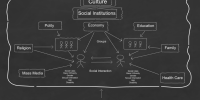INTRODUCTION:
After a long sacrifice and fight Bangladesh became a sovereign country in the year of 1971. The researcher has discussed about the history of methodology after independence to present age in Bangladesh. The methodologies of Geography teaching which have been prescribed in teacher education course hi this country are borrowed more or less from other developed countries. The methodologies require some preliminary conditions for the effective application in the classroom. Present conditions obtained in most of the schools specially in the educationally backward areas are not conducive to their full application for some reasons.
Reasons are:-
1. Teacher’s teaching load is heavy.
2. Classes are over crowded.
3. Usually back benchers are inattentive.
4. Teaching aids are few and far between.
5. Majority of the students belongs to low socio-economic strata of society.
6. Parents have no ability to guide then” wards specially in Geography subject.
So, the students were not inspired hi teaching learning situation in classroom due to lack of motivation from home and school. Considering all the facts the present researcher has tried with a new method, which can be better alternative to all the other methods of teaching hi our present school condition specially in the educationally backward area.
The purpose of the study:
The purpose of the study composite social interaction model of teaching Geography is to find out a model of teaching which will be applicable to the aforementioned students.
Related studies:
The researcher has taken the opportunity of presenting her acquaintance with various literatures related to the present study.
Steps of Application of the Model:
Teaching Geography as a subject in class VII is divided in different chapters, units and sub-cents. Then teacher will divide the students in different groups. The teacher will select some class room monitors and Tutors. Time to time monitors and Tutors will be changed. Monitor will control the class and student tutor will act as a representative of the teacher with in the Group.
Primarily the teacher will represent the contents in the classroom and teachers will technically apply the short answer type questions related to knowledge, understanding, application and skill.
Teacher will choose short questions and student will underline in their own text book. Then the teacher will ask the students to get the lesson by heart and write them at home in an exercise book.
In the next class students will exchange their assigned with the direction of the monitor. Then the tutor will ask the students a few questions from the previous days home tasks. If the errors exceed a certain limit, it will be reported to the teacher. The teacher will examine the tutors and monitors too.
After the completion of some lessons teacher will make a complete evaluation of group wise performance of the students, better performer of the students group would be awarded.
Salient Features of this Model:
1. To devise a method for involving the students in teaching learning situations in the class room and at home.
2. To increase students participation pupil interaction.
3. To introduce a procedure that automatically involving repeated learning of lessons, helping retention.
4. To cultivate a habits of writing.
5. To make the students conversant with different types of questions and mode of answers.
6. To modify the behavior of deliberately in attentive students.
7. To make the students sociable.
The Sample:
On the basis of characteristics of present research only students of class VII Bengali Medium Secondary School of North part of Mirpur, Dhaka District and Karaniganj, South part of Munshiganj. Bangladesh has been considered, those schools belong to educationally backward area.
Design of the study:
It is evident from the sample that there will be eight groups consisting of four pairs of groups. In each pair there will be an experimental group and controlled one. As the groups and the students of a group will be randomly selected, so the design of the study can be named as “Randomized Two Groups Design.” But as the experimental and controlled groups are not identical. So a co-variable is to be used to equate the groups. For this purpose the data has to be processed with the Help of ANCOVA (A Standardized Intelligence Test will be used hi this study as co-variable as the co-relation between the Intelligence and achievement hi Geography is very high). Thus finally, the design of the present study can be named as Randomized Two Groups Co-variance Design.
Hypotheses of the study:
1 . The Composite Social Interaction Model of Teaching Geography is comparatively more effective than that of conventional one.
2. The composite social interaction model of teaching geography is effective in urban area.
3 . This model is effective hi rural area.
4. This model is effective for the Boys.
5. This model is effective for the Girls.
6. This model of teaching helps better retention hi learning than that of done by conventional one.
7. This model of teaching helps the students hi the development of choice status.
Tools to be used for this Study:
1 . Intelligence Test developed and standardized by Bho Hacharyya (1 980).
2. Achievement Test has been constructed and standardized by researcher herself.
3. Sociomertic Test (Bronfeabrenner, 1945), is used hi this study to measure the choice status of the students.
The content area of the construction of the Achievement Test:
Geographical explanation of Bangladesh in class VII has been taken for treatment to control and experimental groups. According to the design of the study the researcher is to measure the outcome of the students in the said, content area for that reason she has to construct an Achievement Test on that topic.
Reliability of the Achievement Test by test retest method is 0.98. The content validity was estimated and concurrent validity of the Achievement Test are found to be 0.58,0.76 and 0.63 respectively.
The statistical validity of the Achievement Test has been found to be 54 Bronfenbrenner’s (1945). Sociometric Test is used in this study to measure the choice status of the students.
When and where necessary the following test have been administered.
1. Intelligence Test.
2. Achievement Test.
3. Sociometric Test.
Researcher has presented the scores of the different tests of different groups of the sample. The aforementioned data has been computed following the principles of Analysis of Covariance (ANCOVA) with the help of computer.
The Results:
Experiment for all Four Groups. Analysis of co-variance:-
| sv | D.F | S.S.X | S.S.Y | S.S.XY | S.S.YX | MS.YX (V.YX) | S.D.YX |
| Among means | 1 | 1705.09 | 390.14 | 815.61 | 314.63 | 314.63 | |
| Within Groups | 111 | 6174.22 | 10232.59 | 42.76 | 10232.29 | 57.81 | 7.60 |
| Total | 178 | 7879.31 | 10622.73 | 772.86 | 10546.92 |
Fy.X = 5.4424925
Significant at the 0.01 level (Appendix-8)
So, our Hypothesis No.l is retained.
Experiment for Urban:
Analysis of co-variance:
| sv | D.F | S.S.X | S.S.Y | S.S.XY | S.S.YX | MS.YX (V.YX) | S.D.YX |
| Among means | 1 | 74.76 | 1856.02 | 372.49 | 1308.09 | 1308.09 | |
| Within Groups | 177 | 3853.69 | 9170.22 | 2926.07 | 6948.49 | 39.26 | 6.27 |
| Total | 178 | 3928.44 | 11026.24 | 3298.56 | 8256.58 |
Fy.X = 33.321224
Significant at the 0.01 level (Appendix-9)
So, our Hypothesis No.2 is retained.
Experiment for Rural: Analysis of co-variance:
| SV | D.F | S.S.X | S.S.Y | S.S.XY | S.S.YX | MS.YX (V.YX) | S.D.YX |
| Among means | 1 | 0.00 | 322.67 | 0.00 | 322.67 | 322.67 | |
| Within Groups | 177 | 2521.00 | 7167.66 | 1660.83 | 6073.50 | 34.31 | 5.86 |
| 178 | 2521.00 | 7490.33 | 1660.83 | 6396.17 |
F.YX = 9.4036368
Significant at the 0.01 level (Appendix-10)
So, our Hypothesis No.3 is retained.
Experiment for Boys:
Analysis of co-variance:
| SV | D.F | S.S.X | S.S.Y | S.S.XY | S.S.YX | MS.YX (V.YX) | S.D.YX |
| Among means | 1 | 99.76 | 1705.09 | 412.42 | 1399.93 | 1399.93 | |
| Within Groups | 177 | 3545.19 | 6174.22 | 1190.76 | 5774.31 | 32.62 | 5.71 |
| 178 | 3645.24 | 7879.31 | 1603.18 | 7174.23 |
Fy.X = 42.912039
Significant at the 0.01 level (Appendix-11).
So, our Hypothesis No.4 is retained.
Experiment for Girls:
Analysis of co-variance:
| sv | D.F | S.S.X | S.S.Y | S.S.XY | S.S.YX | MS.YX (V.YX) | S.D.YX |
| Among means | 1 | 1.80 | 390.14 | -26.50 | 439.24 | 439.24 | |
| Within Groups | 177 | 3316.00 | 10232.59 | 2995.07 | 7527.39 | 42.53 | 6.52 |
| 178 | 3317.80 | 10622.73 | 2968.57 | 7966.63 |
Fy.X= 10,328324
Significant at the 0.01 level.(Appendix-12)
So, our Hypothesis No.5 is retained.
Experiment for Relation:
Analysis of co-variance:
| SV | D.F | S.S.X | S.S.Y | S.S.XY | S.S.YX | MS.YX (V.YX) | S.D.YX |
| Among means | 1 | 520.20 | 1274.67 | 814.30 | 1034.54 | 1034.54 | |
| Within Groups | 177 | 8776.44 | 9116.19 | 999.98 | 9002.25 | 50.86 | 7.13 |
| 178 | 9296.64 | 10390.86 | 1814.28 | 10036.80 |
Fy.X = 20.340958
Significant at the 0.01 level. (Appendix-13)
So, our Hypothesis No.l is retained.
The results of initial and final choice status (results are stated below) indicate that the choice of the experiment groups has been developed for better than that of control group, so our hypothesis No. 7 is retained.
| Choice status of Experimental + control groups | ||||
| Experimental Group | Control Group | |||
| Initial | After Six month | Initial | After Six month | |
| Popular 15 and above | 4 | 8 | 6 | 7 |
| Above Average (10+14) | 10 | 15 | 10 | 9 |
| Average (9) | 6 | 11 | 5 | 6 |
| Below average (4-8) | 12 | 9 | 16 | 16 |
| Neglected (1-3) | 9 | 2 | 12 | 11 |
| Isolate (0) | 4 | 0 | 3 | 3 |
| Total | 45 | 45 | 5 | 52 |
To conclude briefly that the composite social Interaction Model of Teaching Geography is very effective for the students of educationally back ward area. There is no immense scope of pupil-pupil interaction in the process of learning and good relationship among the students and this lead to development of some questions of leadership which is very essential for any democratize country. The method itself creating more stress for the individual teachers own stress is reduced. The model of teaching is that the students hi learning but also in the development of personality.
BIBLIOGRAPHY
| Baron, D. & Baring EM. | Evaluation Techniques of Teachers. New York Me Grow Hell Book Co, the 1958.
|
| Iman Ali | Composite Social Interaction Model of Teaching life science 1995.
|
| Ormell, C.P | “Bloom’s Taxonomy and objectives of Education” Educational Research NFER publishing company Ltd, Vote. 17, No.l, November 1974.
|
| Bloom. B.S.[Ed] | Taxonomy of Educational objectives Hand Book-1 (Cognitive Domain) New York Longmans Green Co, 1956.
|
| De, D.K | Comparative study on the strategy of Composite Social Interaction Model of Teaching and the Strategy of computational Model of Teaching life science . 3 January,1995.
|
The End

















